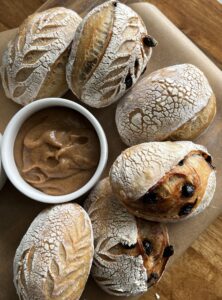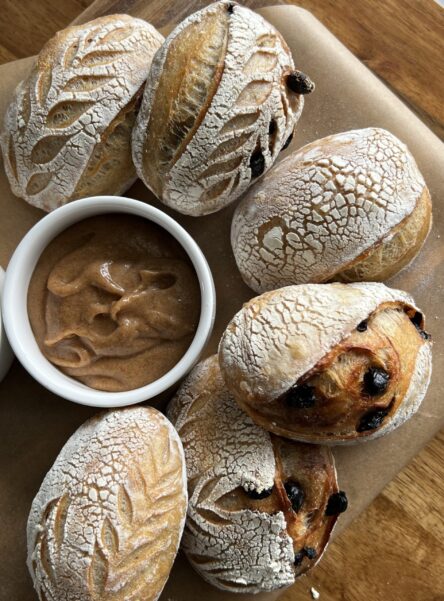Mini Sourdough Loaves
Indulge in the delightful tangy flavors of Mini Sourough Loaves! These petite loaves boast a robust sourdough taste in every bite. Ideal for individual servings or sharing with loved ones, these mini loaves are a testament to artisanal baking at its finest. Whether enjoyed as a savory breakfast treat or paired with your favorite spread, these mini sourdough loaves promise to elevate your culinary experience!

Ingredients You Need:
Full ingredients and recipe are in the recipe card below. Read through this section for all the ingredients substitution and baking tips!
-
Bread flour
-
Whole wheat flour
-
Water
-
Salt
-
Levain (fed sourdough starter)
-
Cinnamon
-
Raisins
Sample Sourdough Bread Schedule:
Day 1: Evening Starter Feeding (2 days before baking)
-
Feed the Starter:
-
Take your sourdough starter out of the fridge and discard some of it, if needed.
-
Feed the starter with equal parts flour and water by weight (e.g., 50g flour and 50g water).
-
Mix well until incorporated, cover loosely, and let it sit at room temperature overnight (about 8-12 hours) to ferment and become active.
-
Day 2: Dough Preparation (1 day before baking)
-
Autolyse:
-
In the morning, about 1 hour before you plan to start mixing the dough, mix the flour and water in the recipe (excluding the levain and salt) in a large bowl.
-
Cover the bowl and let it rest for 1 hour at room temperature.
-
-
Mixing:
-
After the autolyse period, add the levain (70g) to the autolysed flour and water mixture.
-
Mix until the levain is fully incorporated into the dough.
-
Cover the bowl and let it rest for 30 minutes at room temperature.
-
-
Adding Salt and Mixing:
-
Sprinkle salt evenly over the dough.
-
Mix the salt into the dough thoroughly, ensuring even distribution (35 minutes). You can use your hands or a dough scraper to incorporate the salt.
-
Cover the bowl and let it rest for 30 minutes at room temperature.
-
-
Bulk Fermentation:
-
Perform one stretch and fold 30 minutes after adding the salt. Cover the bowl and let rest for 30 minutes at room temperature.
-
Then perform 3 rounds of coil folds, set apart by 45 minutes in between each to strengthen the dough.
-
Cover the dough and let it rest at room temperature until the end of bulk fermentation. This typically takes around 5-8 hours total, depending on room temperature and the activity of your starter.
-
-
Shaping:
-
Once the dough has noticeably increased in volume (doubled in size) and feels airy and slightly puffy, it’s ready to shape. Gently shape each mini loaf into a batard shape (more detailed shaping instructions in the recipe below), being careful not to deflate it too much.
-
-
Cold Fermentation:
-
Place the shaped dough in a baguette pan or small bowls lined with a floured cloth. Cover with a kitchen towel or loosely with plastic wrap.
-
Transfer the dough to the refrigerator and let it cold ferment overnight.
-
Day 3: Baking
-
Preheat Oven:
-
About 1 hour before baking, preheat your oven to the desired temperature (450°F/232°C) with a Dutch oven or baking stone inside.
-
-
Baking:
-
Once the mini loaves have finished cold fermenting, carefully invert them (3 at a time) onto a piece of parchment paper. Place the other 3 mini loaves into the fridge until the first batch is baked off.
-
Score the dough with a sharp knife or lame to allow for expansion during baking.
-
Transfer the 3 mini loaves to the Dutch oven or baking stone. Bake with the lid on for the first 20 minutes to trap steam, then reduce the temperature to 400°F/204°C. Remove the lid and continue baking for another 15-18 minutes or until the crust is golden brown and the bread sounds hollow when tapped on the bottom.
-
-
Cooling:
-
Once baked, remove the bread from the oven and let it cool on a wire rack for at least an hour before slicing. This allows the crumb to set properly.
-
Sourdough Terms Defined:
-
Sourdough Starter: A fermented mixture of flour and water that contains wild yeast and lactobacilli bacteria. It is used to leaven sourdough bread and develop its characteristic flavor.
-
Levain: Also known as sourdough culture or preferment, it’s a portion of the sourdough starter that is mixed with fresh flour and water to create a leavening agent for bread dough.
-
Autolyse: A technique in bread making where flour and water are mixed together and allowed to rest before adding the other ingredients. This helps develop gluten and improve dough hydration.
-
Bulk Fermentation: The initial rise of the dough after mixing in the levain, during which the yeast and bacteria ferment the sugars in the flour, producing carbon dioxide and organic acids. This stage develops flavor and structure in the dough.
-
Stretch and Fold: A technique used during bulk fermentation to strengthen the gluten network in the dough. The dough is stretched and folded over itself multiple times at intervals to build structure.
-
Coil Fold: A variation of the stretch and fold technique where the dough is lifted from the sides and folded into the center in a coil-like motion. This helps redistribute yeast and gases, improving dough strength and structure.
-
Proofing Basket (Banneton): A basket or bowl, usually made of cane or rattan, used to support the shaped dough during its final rise (proofing). It helps the dough maintain its shape and creates attractive patterns on the crust.
-
Scoring: The process of making shallow cuts or slashes on the surface of the dough just before baking. This helps control the expansion of the dough during baking and creates decorative patterns on the crust.
-
Cold Fermentation (Retardation): A technique where the shaped dough is refrigerated for an extended period, typically overnight, to slow down fermentation. This enhances flavor development and improves the texture of the bread.
-
Dutch Oven: A heavy, lidded pot made of cast iron or ceramic used for baking bread. When preheated, it creates a steamy environment that mimics professional bread ovens, resulting in a crispy crust and a moist crumb.
-
Crumb: The interior texture of the bread, including its air pockets, structure, and moisture content. A well-developed crumb is airy, light, and evenly distributed.
-
Hydration: The ratio of water to flour in the dough, expressed as a percentage. Higher hydration doughs are wetter and more extensible, while lower hydration doughs are drier and stiffer.
-
Starter Feeding: The process of refreshing the sourdough starter by discarding a portion and feeding the remaining starter with fresh flour and water. This maintains the activity and health of the starter culture.
-
Lame: A tool used for scoring bread dough, typically consisting of a handle and a replaceable razor blade. It allows for precise cuts and decorative patterns on the dough’s surface.
-
Fermentation: The process by which yeast and bacteria in the sourdough culture metabolize sugars in the flour, producing carbon dioxide and organic acids. This process gives sourdough bread its characteristic flavor, aroma, and texture.

Tips for making Mini Sourdough Loaves:
-
Healthy and Active Sourdough Starter: Ensure your sourdough starter is healthy, active, and bubbly before using it in your recipe. A lively starter will provide the necessary leavening for your mini loaves and impart delicious flavor.
-
Room Temperature Ingredients: Use room temperature ingredients, including the sourdough starter, water, and any other wet ingredients. This helps with proper fermentation and ensures a consistent rise.
-
Autolyse: Consider incorporating an autolyse step, which involves mixing the flour and water and allowing it to rest for 30 minutes before adding the sourdough starter and salt. This helps improve gluten development and hydration in the dough.
-
Bulk Fermentation: Allow the dough to undergo bulk fermentation at room temperature for several hours or until it has doubled in size. This step is crucial for developing flavor and structure in your mini loaves.
-
Shaping the Loaves: Once the dough has completed bulk fermentation, gently shape it into mini loaves. You can divide the dough into equal portions and shape them into rounds or elongated shapes, depending on your preference.
-
Proofing: Place the shaped mini loaves on a lightly floured surface (I use a baguette pan lined with a kitchen towel, and dusted with flour) or in proofing baskets and allow them to proof for a final rise. This step helps the loaves develop a light and airy texture.
-
Scoring: If desired, use a sharp knife or bread lame to score the tops of the mini loaves before baking. Scoring helps control the expansion of the dough during baking and creates an attractive pattern on the crust.
-
Baking: Preheat your oven to the specified temperature and bake the mini sourdough loaves until they are golden brown and sound hollow when tapped on the bottom. The exact baking time may vary depending on the size of your loaves and your oven.
-
Cooling and Storage: Once baked, transfer the mini sourdough loaves to a wire rack to cool completely before slicing and serving. Store any leftovers in an airtight container at room temperature for up to several days or freeze them for longer storage.
-
Experiment and Enjoy: Don’t be afraid to experiment with different flours, hydration levels, and shaping techniques to find the perfect recipe for your mini sourdough loaves. And most importantly, enjoy the process and savor the delicious results!

How to store Mini Sourdough Loaves:
-
Room Temperature: Store the mini sourdough loaves in a paper bag or bread box at room temperature for up to 2-3 days. This helps maintain the crusty exterior while keeping the inside moist. Avoid plastic bags, as they can make the crust soft.
-
Refrigeration: If you need to store the bread for longer, place the loaves in a plastic bag or airtight container and refrigerate them. They can be kept in the refrigerator for up to a week. Be aware that refrigeration can dry out the bread, so consider reheating it before serving.
-
Freezing: To freeze the mini sourdough loaves, wrap them tightly in plastic wrap and then in aluminum foil. Place the wrapped loaves in a freezer-safe bag or container. They can be frozen for up to 3 months. Thaw the loaves in the refrigerator overnight or at room temperature before serving.
-
Slicing Before Freezing: For convenience, slice the mini loaves before freezing. Place slices in a single layer on a baking sheet and freeze until solid. Then, transfer the frozen slices to a freezer-safe bag or container. This allows you to take out only the amount you need and keeps the rest fresh.
-
Reheating: To restore the crusty texture, reheat the loaves in a preheated oven at 350°F (175°C) for 10-15 minutes. For slices, use a toaster or oven. This helps revive the bread’s freshness and makes it taste like it’s just been baked.
-
Avoid Moisture: If you live in a humid environment, avoid storing bread in a damp area. Excess moisture can cause the bread to mold quickly. Instead, use a bread box with good air circulation or a paper bag.
-
Bread Bag with Ventilation: Consider using a bread bag with ventilation holes if you prefer to store bread at room temperature. This type of bag helps balance humidity, keeping the bread crusty and preventing it from becoming too dry or too soft.

